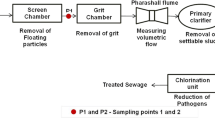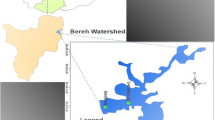Abstract
The objective of this study was to determine the occurrence of triclosan in the tropical rivers where received the effluents from a hospital wastewater treatment plant (HWWTP) in southern Taiwan. Three and ten sampling sites were selected at the Jiaosu River (S0–S2) and Dian-Bao River (S3–S12), respectively. The samples of the HWWTP influent, effluent and receiving river water and sediment were collected and analyzed using ultrahigh-performance liquid chromatography-tandem mass spectrometry (UHPLC-MS/ MS). Results showed that the triclosan level in surface water of the Jiaosu River and Dian-Bao River ranged from 3 to 68 ng/L and ranged from <2.7 to 51 ng/L, respectively. The hospital did contribute a loading of triclosan to the neighboring river. The mean value of triclosan concentration in the downstream surface water of the Jiaosu River (S1 20.2 ng/L) was approximately three times higher than that of the background level (S0 6.0 ng/L) (p = 0.011). The concentrations of triclosan in two surface water samples were over the predicted no effect concentration (PNEC) of 50 ng/L for algae. In addition, significant seasonal differences of triclosan in surface water of Jiaosu River (p = 0.020) and the HWWTP effluents (p = 0.302) were also observed. The concentrations of triclosan in sediments of these two rivers seemed stable. On average, triclosan was detected in 86 % of the sediment samples with a range from <1.1 to 13 ng/g. Triclosan in surface water and sediments of the tropical rivers might be rapidly photolyzed due to plenty of sunshine. It is worth to further investigate the occurrence and fate of triclosan photoproduct in the aquatic environment of the tropics.

Similar content being viewed by others
References
Buth, J. M., Grandbois, M., Vikesland, P. J., McNeill, K., & Arnold, W. A. (2009). Aquatic photochemistry of chlorinated triclosan derivatives: potential source of polychlorodibenzo-p-dioxins. Environmental Toxicology and Chemistry, 28, 2555–2563.
Canosa, P., Rodriguez, I., Rubí, E., & Cela, R. (2005a). Optimization of solid-phase microextraction conditions for the determination of triclosan and possible related compounds in water samples. Journal of Chromatography A, 1072, 107–115.
Canosa, P., Morales, S., Rodríguez, I., Rubí, E., Cela, R., & Gómez, M. (2005b). Aquatic degradation of triclosan and formation of toxic chlorophenols in presence of low concentrations of free chlorine. Analytical and Bioanalytical Chemistry, 383, 1119–1126.
Ciba-Geigy (1998). IRGASAN DP 300/IRGACARE MP: toxicological and ecological data/Official registration. Brochure no 252.
Crofton, K. M., Paul, K. B., Devito, M. J., & Hedge, J. M. (2007). Short-term in vivo exposure to the water contaminant triclosan: evidence for disruption of thyroxine. Environmental Toxicology and Pharmacology, 24, 194–197.
European Commission (2009). Regulation (EC) 1272/2008. Annex VI. Table 3.2. http://eur-lex.europa.eu/LexUriServ/LexUriServ.do?uri=OJ:L:2008:353:0001:1355:en:PDF.
Kanetoshi, A., Ogawa, H., Katsura, E., Kaneshima, H., & Miura, T. (1992). Study on the environmental hygienic chemistry of chlorinated 2-hydroxydiphenyl ethers: photolytic conversion to polychlorinated dibenzo-p-dioxins. Journal of Environmental Chemistry, 2, 515–522.
Kolpin, D. W., Furlong, E. T., Meyer, M. T., Thurman, E. M., Zaugg, S. D., Barber, L. B., & Buxton, H. T. (2002). Pharmaceuticals, hormones, and other organic wastewater contaminants in U.S. streams, 1999-2000: a national reconnaissance. Environmental Science & Technology, 36, 1202–1211.
Kumar, V., Chakraborty, A., Kural, M. R., & Roy, P. (2009). Alteration of testicular steroidogenesis and histopathology of reproductive system in male rats treated with triclosan. Reproductive Toxicology, 27, 177–185.
Latch, D. E., Packer, J. L., Arnold, W. A., & McNeill, K. (2003). Photochemical conversion of triclosan to 2,8-dichlorodibenzo-p-dioxin in aqueous solution. Journal of Photochemistry and Photobiology A: Chemistry, 158, 63–66.
McAvoy, D. C., Schatowitz, B., Jacob, M., Hauk, A., & Eckhoff, W. S. (2002). Measurement of triclosan in wastewater treatment systems. Environmental Toxicology and Chemistry, 21, 1323–1329.
Mezcua, M., Gómez, M. J., Ferrer, I., Aguera, A., Hernando, M. D., & Fernández-Alba, A. R. (2004). Evidence of 2,7/2,8-dibenzodichloro-p-dioxin as a photodegradation product of triclosan in water and wastewater samples. Analytica Chimica Acta, 524, 241–247.
Miller, T. R., Heidler, J., Chillrud, S. N., DeLaquil, A., Ritchie, J. C., Mihalic, J. N., et al. (2008). Fate of triclosan and evidence for reductive dechlorination of triclocarban in estuarine sediments. Environmental Science & Technology, 42, 4570–4576.
Nishi, I., Kawakami, T., & Onodera, S. (2008). Monitoring of triclosan in the surface water of the Tone Canal, Japan. Bulletin of Environmental Contamination and Toxicology, 80, 163–166.
Onodera, S., Ogawa, M., & Suzuki, S. (1987). Chemical changes of organic compounds in chlorinated water. XIII. Gas chromatographic-mass spectrometric studies of the reactions of Irgasan DP 300 [5-chloro-2-(2,4-dichlorophenoxy)phenol] with chlorine in dilute aqueous solution. Journal of Chromatography, 392, 267–275.
Rule, K. L., Ebbett, V. R., & Vikesland, P. J. (2005). Formation of chloroform and chlorinated organics by free-chlorine-mediated oxidation of triclosan. Environmental Science & Technology, 39, 3176–3185.
Sabaliunas, D., Webb, S. F., Hauk, A., Jacob, M., & Eckhoff, W. S. (2003). Environmental fate of Triclosan in the River Aire Basin, UK. Water Research, 37, 3145–3154.
Samsøe-Petersen, L., Winter-Nielsen, M., Madsen, T. (2003). Fate and effects of triclosan. Environmental Project No. 861. Danish Environmental Protection Agency.
Singer, H., Müller, S., Tixier, C., & Pillonel, L. (2002). Triclosan: occurrence and fate of a widely used biocide in the aquatic environment: field measurements in wastewater treatment plants, surface waters, and lake sediments. Environmental Science & Technology, 36, 4998–5004.
Wilson, B., Zhu, J., Cantwell, M., & Olsen, C. R. (2008). Short-term dynamics and retention of triclosan in the lower Hudson River Estuary. Marine Pollution Bulletin, 56, 1230–1233.
Wu, J. L., Lam, N. P., Martens, D., Kettrup, A., & Cai, Z. (2007). Triclosan determination in water related to wastewater treatment. Talanta, 72, 1650–1654.
Ying, G. G., Kookana, R. S., & Kolpin, D. W. (2009). Occurrence and removal of pharmaceutically active compounds in sewage treatment plants with different technologies. Journal of Environmental Monitoring, 11, 1498–1505.
Zhang, S., Zhang, Q., Darisaw, S., Ehie, O., & Wang, G. (2007). Simultaneous quantification of polycyclic aromatic hydrocarbons (PAHs), polychlorinated biphenyls (PCBs), and pharmaceuticals and personal care products (PPCPs) in Mississippi river water, in New Orleans, Louisiana, USA. Chemosphere, 66, 1057–1069.
Zhao, J. L., Ying, G. G., Liu, Y. S., Chen, F., Yang, J. F., & Wang, L. (2010). Occurrence and risks of triclosan and triclocarban in the Pearl River system, South China: from source to the receiving environment. Journal of Hazardous Materials, 179, 215–222.
Acknowledgments
The authors wish to thank the National Science Council, Taiwan (Contract No. NSC 100-2221-E-214-010), for the financial support of this study.
Compliance with ethical standards
This study was funded by the National Science Council, Taiwan (Contract No. NSC 100-2221-E-214-010). This article does not contain any studies with human participants or animals performed by any of the authors.
Conflict of interest
The authors declare that they have no conflict of interest
Author information
Authors and Affiliations
Corresponding author
Rights and permissions
About this article
Cite this article
Yang, G.C.C., Tsai, HJ. & Chang, FK. Occurrence of triclosan in the tropical rivers receiving the effluents from the hospital wastewater treatment plant. Environ Monit Assess 187, 151 (2015). https://doi.org/10.1007/s10661-015-4372-2
Received:
Accepted:
Published:
DOI: https://doi.org/10.1007/s10661-015-4372-2




